Overview
Chair yoga serves as a valuable tool for weight loss by promoting physical activity, enhancing flexibility, and improving body awareness, particularly beneficial for individuals with limited mobility.
Regular practice not only leads to gradual weight loss and metabolic improvement but is also most effective when paired with mindful eating.
Furthermore, its accessibility and mental health benefits make it an ideal choice for diverse populations seeking wellness solutions.
Introduction
In a world where fitness trends frequently neglect accessibility, chair yoga emerges as a refreshing alternative, inviting individuals of all ages and abilities to embrace movement and mindfulness. This gentle yet effective practice caters not only to those with limited mobility but also serves as a valuable tool for weight loss and overall wellness.
By adapting traditional yoga poses for a seated position, chair yoga fosters physical activity, enhances flexibility, and cultivates a deeper awareness of the body—all essential components for achieving health goals. As research continues to unveil its benefits, chair yoga is proving to be a vital addition to wellness programs, particularly in corporate settings where stress reduction and employee health are paramount.
Discover how this innovative approach can transform lives and promote a healthier, more balanced lifestyle.
What is Chair Yoga and How Does It Work for Weight Loss?
Seated exercise represents an accessible variation of traditional practices, performed while sitting or using a seat for support during standing positions. This method proves particularly advantageous for individuals with limited mobility, seniors, or those pursuing a gentler approach to fitness. By integrating conventional poses modified for a seated context, participants can engage in stretching, strengthening, and breathing exercises without the necessity of getting on the floor.
When evaluating whether chair yoga effectively contributes to weight loss, this practice plays a vital role by fostering physical activity, enhancing flexibility, and improving overall body awareness. While it may not incinerate as many calories as more vigorous exercise forms, consistent engagement can lead to gradual weight loss and improved metabolic function, particularly when complemented by mindful eating habits. Recent studies indicate that seated exercises can significantly reduce the likelihood of falls by improving balance, a crucial aspect for seniors and individuals facing mobility challenges.
Expert insights underscore the effectiveness of seated exercises in managing body mass. Practitioners who regularly partake in seated postures often report heightened motivation and involvement, essential factors for sustaining a healthy lifestyle. Oppedijk, a seasoned fitness instructor, recommends participating in seated stretching exercises three to five days a week for optimal results.
A compelling case study highlights the impact of seated stretching on seniors, revealing that participants not only experienced weight reduction but also increased energy levels and overall wellness. This aligns with findings from holistic medicine, which emphasize the benefits of movement techniques for natural stress management and comprehensive wellness, addressing the mind, body, and spirit. Moreover, structured routines such as Ayurveda's morning regimen can invigorate the day, further amplifying the advantages of seated exercises.
The simplicity of seated movements is another significant benefit, requiring only a seat, which facilitates easy engagement in various settings, including corporate environments. By incorporating seated stretching into workplace wellness initiatives, organizations can enhance employee health and productivity.
In conclusion, seated stretching prompts the inquiry of whether chair yoga truly aids in weight loss, offering a unique and effective method for shedding pounds, particularly for those who might find conventional exercise daunting. By fostering a consistent routine, individuals can experience gradual weight loss, improved physical fitness, and an enhanced sense of well-being.
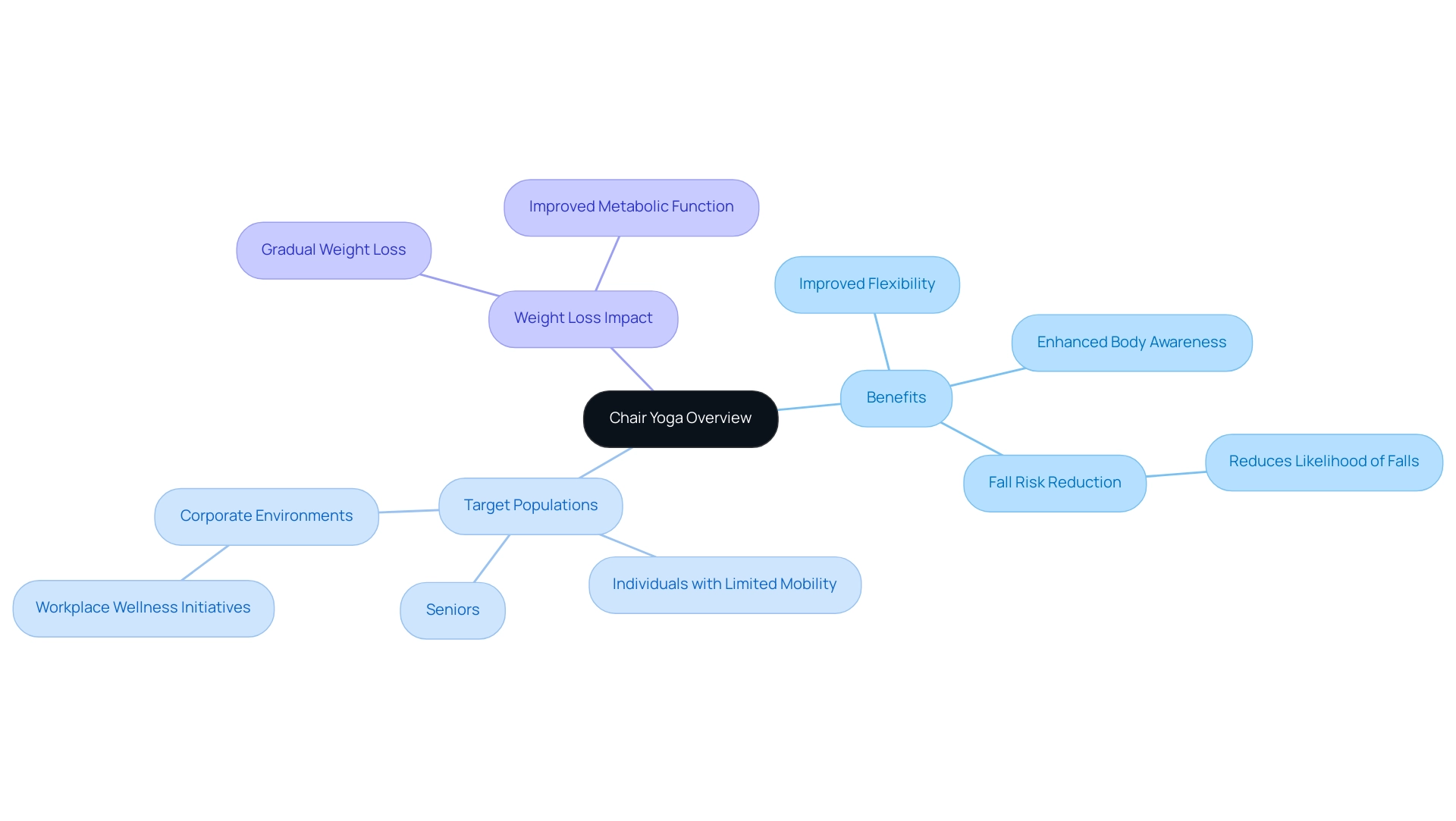
Key Benefits of Chair Yoga for Weight Loss and Wellness
Chair exercises offer a wealth of benefits that extend well beyond the realm of weight loss. Key advantages include:
-
Enhanced Flexibility: Consistent seated stretching practice significantly improves flexibility in joints and muscles, promoting overall mobility and decreasing the chances of injuries. This is particularly beneficial for desk workers who often experience stiffness from prolonged sitting.
-
Stress Reduction: By incorporating mindfulness and breathing techniques, seated exercises effectively lower stress levels. This is crucial for weight management, as elevated stress can trigger emotional eating. Research suggests that individuals in seated stretching report a significant reduction in stress, leading to healthier lifestyle decisions.
-
Enhanced Strength: The gentle movements typical of seated exercise contribute to developing muscle strength, particularly in the core. This improvement supports better posture and stability, which are essential for overall physical health and can lead to increased productivity in the workplace.
-
Enhanced Mindfulness: Participating in seated stretches fosters a greater awareness of physical sensations and dietary practices. This mindfulness fosters a healthier relationship with food, encouraging individuals to make more conscious dietary choices.
-
Accessibility: One of the most significant advantages of chair exercises is its inclusivity. It is suitable for individuals of all ages and fitness levels, making it an approachable option for those who may feel daunted by conventional classes. This accessibility allows more individuals to experience the benefits of this practice without the intimidation factor.
In 2025, statistics indicate that seated stretching not only assists in flexibility and strength but also plays a crucial role in stress alleviation. Significantly, fitness injuries take place at a rate of 1.18 injuries per 1000 sessions, with most of the injured participants being 65 or older, emphasizing the safety of seated exercise for older individuals. Practical instances show that integrating seated stretches into daily activities can reduce muscle tension, improve mental clarity, and avert burnout, ultimately fostering a healthier work environment.
A case study titled 'Benefits of Seat Exercises for Desk Workers' illustrates how seat exercises can relieve muscle tension and promote better posture, further supporting its relevance in corporate settings. Health experts promote seated stretching as an effective method for stress relief and losing pounds, often questioning does chair yoga really work for weight loss while highlighting its contribution to enhancing overall wellness. As seated exercise continues to gain traction, its advantages for loss and wellness are becoming increasingly acknowledged, leading many to ask, does chair yoga really work for weight loss, making it a valuable addition to corporate wellness initiatives.
Furthermore, fitness studios in the US generate around $250,000-$350,000 in annual revenue, reflecting the increasing popularity and acceptance of this practice in wellness initiatives.
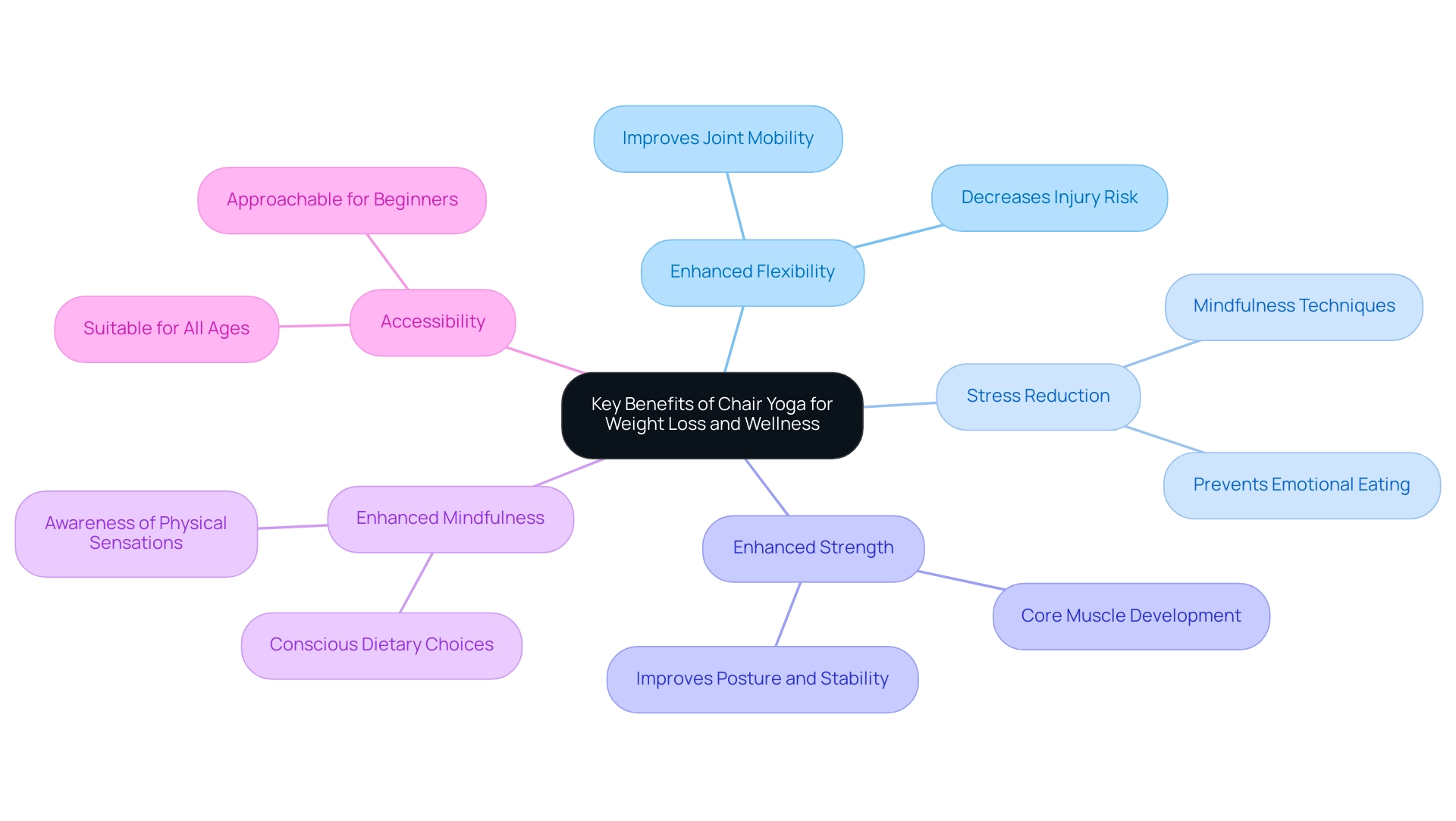
How Chair Yoga Facilitates Weight Loss: Mechanisms Explained
Chair yoga facilitates weight loss through several interconnected mechanisms:
-
Caloric Expenditure: While seated stretching may not match the caloric burn of high-intensity workouts, it promotes movement that contributes to overall caloric expenditure. Many individuals question whether chair yoga truly aids in weight loss; however, regular practice can lead to significant cumulative effects on weight management, making it an accessible option for those who struggle to find time for traditional workouts. Statistics reveal that 15% of individuals abandon exercise programs due to time limitations, underscoring the importance of including adaptable alternatives such as seated exercises.
-
Muscle Engagement: Numerous chair poses engage multiple muscle groups, aiding in the development of lean muscle mass. Increased muscle mass correlates with a higher resting metabolic rate, prompting the inquiry: does chair yoga really work for weight loss? This practice allows for more calories to be burned even at rest.
-
The combination of gentle movement and mindful breathing enhances metabolic function, crucial for digestion and nutrient absorption—key components in effective body mass management, raising the question: does chair yoga really work for weight loss?
-
Stress Reduction: Chair exercises incorporate relaxation techniques that can lower cortisol levels. This decrease in stress hormones leads to the inquiry: does chair yoga really work for weight loss, particularly in alleviating stress-related weight gain in the abdominal region? As Charlotte Maxwell-Davies, Head of Workplace Mental Health and Training from Mental Health UK, notes, "exercise can help reduce feelings of anxiety and depression, boost self-esteem, and provide a sense of accomplishment."
-
Mindful Eating: The awareness developed during seated stretching sessions can positively influence eating habits. Participants often report healthier food choices and better portion control, leading to the question: does chair yoga really work for weight loss? Notably, studies indicate that women prioritize weight loss (39%) and self-assurance (29%) more than men (27% and 18%, respectively) as fitness objectives, suggesting that seated exercise can be particularly appealing to female participants.
Research indicates that participating in seated stretching, such as chair yoga, raises the question of whether chair yoga truly works for weight loss, with studies showing that participants can burn approximately 150-200 calories per hour, depending on session intensity. Furthermore, case studies emphasize that interventions integrating aerobic and resistance training yield superior outcomes in weight loss and overall fitness compared to either method individually. This suggests that incorporating seated stretching into a broader fitness routine can enhance its effectiveness.
In summary, when considering whether chair yoga really works for weight loss, it is essential to note that seated exercises not only assist in weight loss through physical activity but also promote a comprehensive approach to health by addressing mental wellness and lifestyle choices. By advocating for such programs, Foresight Health Coaching encourages organizations to invest in their team's health, fostering a stronger and more resilient team culture.
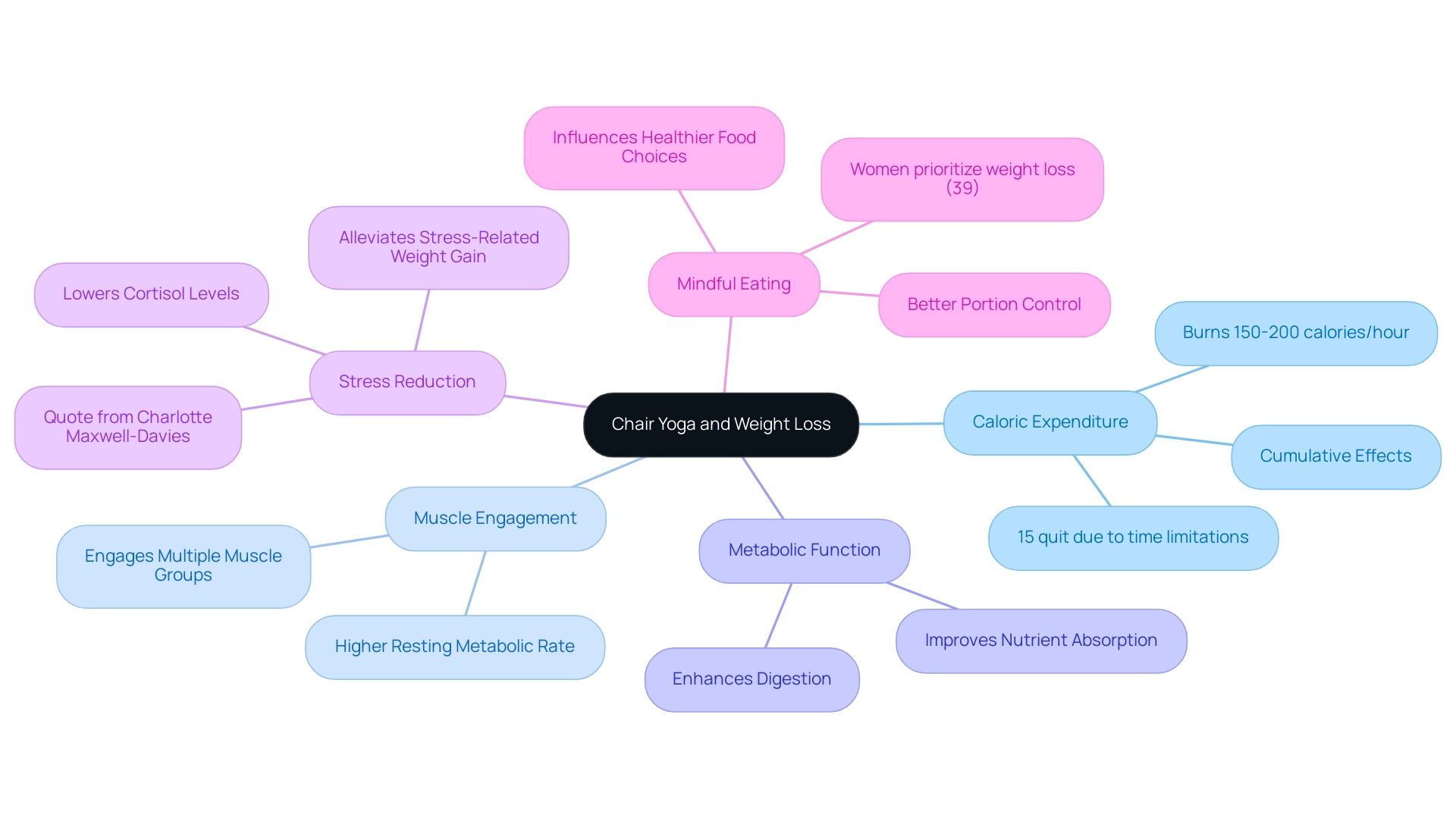
Effective Chair Yoga Exercises for Weight Loss: A Practical Guide
Many people question whether chair yoga truly aids in weight loss, given its array of effective activities that contribute to overall well-being. Consider these key poses:
- Seated Mountain Pose: Begin by sitting tall with your feet flat on the ground. Engage your core and reach your arms overhead, holding this position for several breaths. This pose not only strengthens the core but also improves posture, setting a solid foundation for further exercises.
- Chair Warrior II: From a seated position, extend one leg out to the side while reaching your arms parallel to the ground. This pose is excellent for building strength in the legs and core, essential for maintaining balance and stability.
- Seated Forward Bend: While seated, gently reach for your toes to stretch the hamstrings and lower back. This pose promotes flexibility and relaxation, which are crucial for recovery and stress management.
- Chair Pigeon Pose: Cross one ankle over the opposite knee and gently press down on the raised knee. This pose opens the hips, relieving tension and improving mobility, which can be particularly beneficial for those with sedentary lifestyles.
- Seated Side Stretch: Raise one arm overhead and lean to the opposite side to stretch the side body. This enhances flexibility and helps relieve stress, contributing to a more balanced mental state.
Integrating these seated stretching exercises into a regular routine can significantly elevate physical activity levels, thereby prompting the inquiry: does chair yoga really work for weight loss and overall health? Studies indicate that even short daily sessions can yield substantial benefits, making chair practices an accessible option for individuals at all fitness levels. As Emma Mitchell, a physiotherapist at Bupa UK, notes, "Looking for a quick stretching routine?"
Try our Morning practice – this relaxing video routine only takes 12 minutes to do and will help get your day off to a flying start.
Moreover, the regularity of seated exercises is crucial for optimal outcomes. Beginners are advised to start with 1-2 days per week, gradually increasing to 3-5 days for maximum benefits, as established in recent case studies. With more individuals adopting this practice—projected to reach 55 million practitioners in the U.S. by 2025—the potential for chair exercises to enhance workplace wellness and productivity becomes increasingly evident.
By establishing a consistent practice, individuals can experience improved flexibility, strength, and a greater sense of well-being, which raises the question: does chair yoga really work for weight loss?
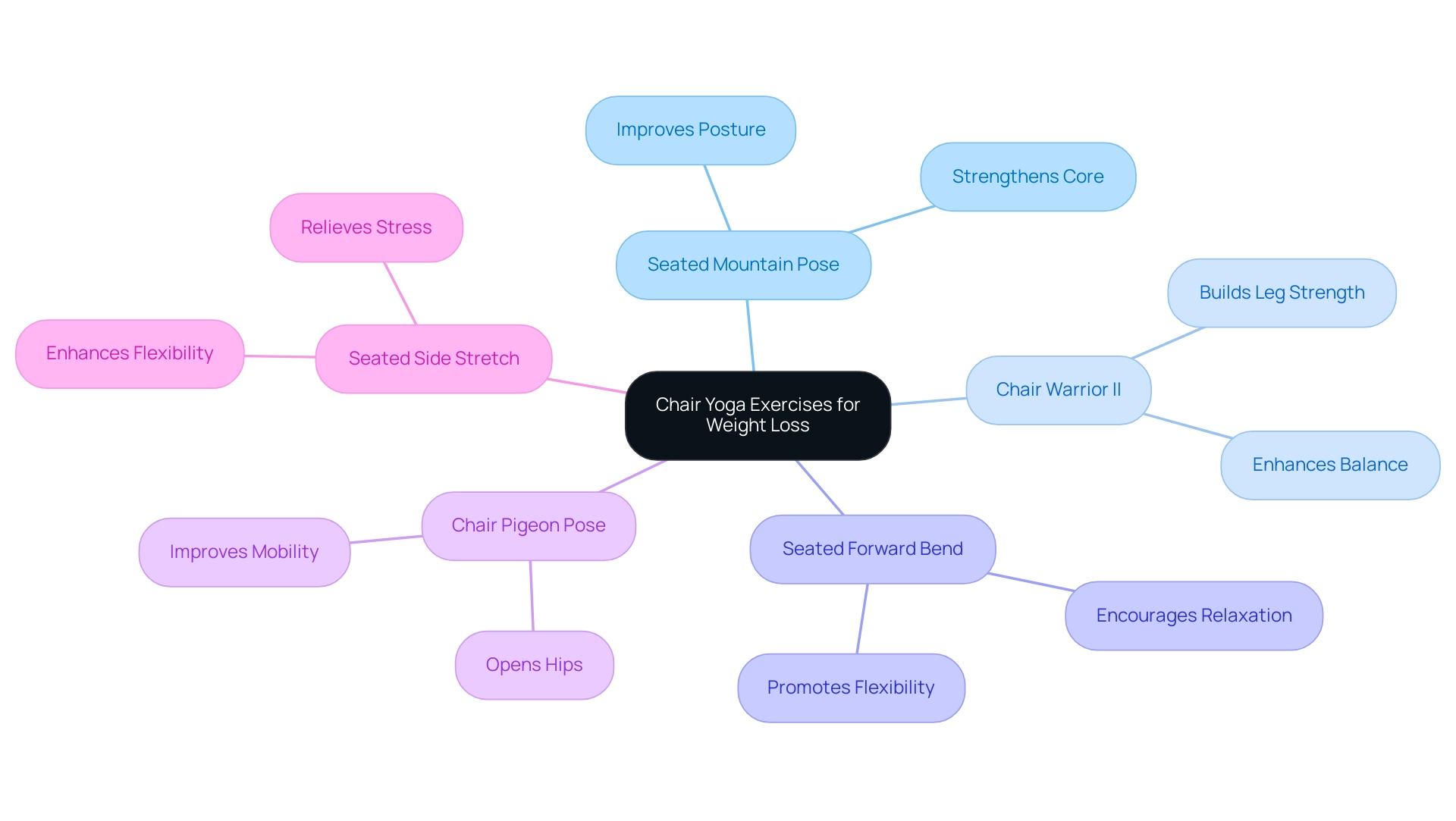
Chair Yoga for Everyone: Accessibility and Adaptability in Weight Loss Programs
Chair yoga is specifically designed to be accessible for individuals of all ages and physical abilities, making it an excellent option for various groups, including:
- Seniors: Older individuals can significantly gain from seated exercise, as it reduces the chance of falls while improving strength and flexibility. This form of exercise is particularly important for maintaining mobility and independence in later years.
- Individuals with Disabilities: Those facing mobility challenges can engage in chair exercises to enhance their physical health without the need for complex movements. This adaptability allows for a more inclusive approach to fitness, ensuring that everyone can engage in physical activity.
- Office Workers: Chair exercises can be seamlessly integrated into the workday, enabling employees to take short breaks for movement and stress relief. This routine not only promotes physical well-being but also enhances mental clarity and focus, contributing to overall productivity. In fact, statistics indicate that employees who exercise for at least 30 minutes three times per week are more likely to report feeling motivated at work, highlighting the importance of incorporating physical activity into daily routines.
- Beginners: Newcomers to the practice can begin with seated exercises to build confidence and familiarity with routines. This gentle introduction allows individuals to ease into more advanced forms of practice as they progress.
The inclusiveness of seated exercise not only aids physical well-being but also fosters a sense of community and assistance among participants. This aspect is particularly valuable in workplace wellness programs, where fostering a cohesive team culture is essential.
Statistics suggest that seated exercise involvement rates among office employees are increasing, demonstrating a rising awareness of its advantages. Moreover, research has indicated that consistent participation in seated stretching can result in notable enhancements in mental well-being, encompassing decreased stress and anxiety, which are vital for sustaining a productive work atmosphere. Health experts highlight the significance of accessibility in seated exercise, mentioning that it functions as an effective fitness program for varied groups.
As emphasized by Ching-Teng Yao, "The seated exercise training offers a straightforward and cost-effective fitness program that enhances functional health and overall well-being efficiently."
Recent case studies, like the "Corporate Wellness Partnership" by Foresight Health Coaching, illustrate how seated stretches can be part of a wider corporate wellness program, highlighting the possible enhancements in job performance and employee satisfaction. However, it is important to acknowledge the need for further research to develop better protocols and enhance evidence-based information regarding seated exercise, particularly for older adults. By incorporating chair exercises into corporate wellness initiatives, organizations can invest in the health of their teams, ultimately leading to improved job performance and employee satisfaction.
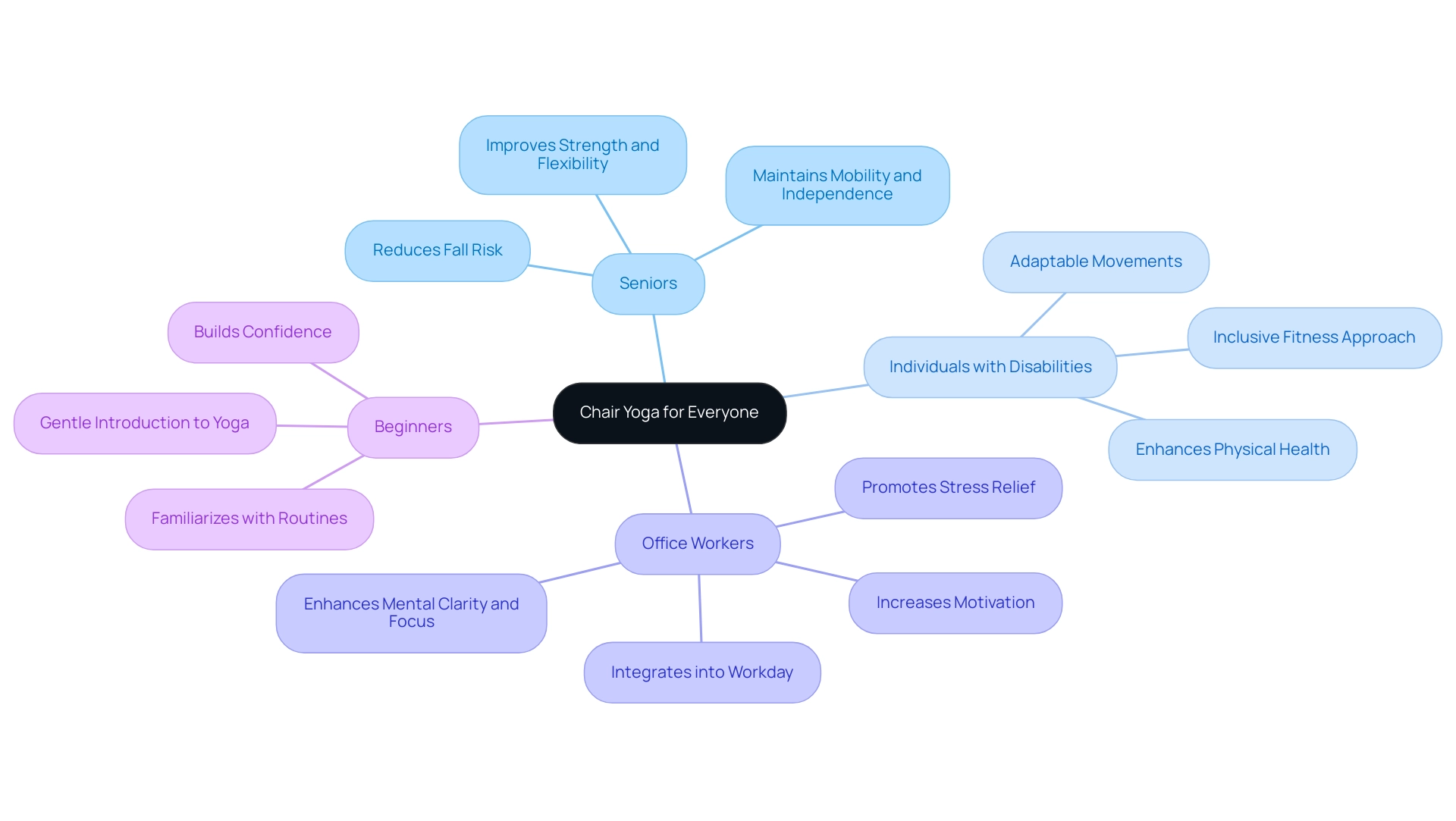
The Mind-Body Connection: How Chair Yoga Supports Mental Health and Weight Loss
Chair exercises serve as a powerful tool, enhancing not only physical health but also significantly improving mental well-being. This practice fosters mindfulness, leading to several key benefits:
-
Reduced Anxiety and Stress: The combination of mindful breathing and gentle movements in seated exercises effectively calms the mind, helping to lower anxiety levels that often trigger emotional eating. Research shows that mindfulness techniques can greatly lessen anxiety, making seated stretching a valuable inclusion in stress management approaches. Significantly, studies indicate that activities such as Tai Chi can effectively reduce the likelihood of depression, further endorsing the mental health advantages of seated exercise.
-
Improved Mood: Regular participation in seated stretching has been linked to enhanced mood and emotional resilience. This uplift in emotional state supports healthier lifestyle choices, creating a positive feedback loop that encourages ongoing participation in wellness activities. In the context of post-COVID-19 recovery, many individuals have turned to complementary medicine and mind-body therapies, including seated exercises, to address ongoing symptoms and enhance their mental health. Personalized coaching from Corporate Membership - Contact Our Health Coaches Today can further enhance this experience, providing tailored support to help individuals thrive.
-
Enhanced Focus and Clarity: The meditative aspects of seated stretching contribute to improved concentration and cognitive function. This heightened mental clarity aids individuals in making better decisions regarding food and exercise, which is crucial for effective weight management. A case study titled 'Long-term Tai Chi Practice and Cognitive Abilities' discovered that consistent Tai Chi practice aids in preserving and enhancing cognitive functions, especially in episodic memory and executive function, which can be compared to seated exercise practices.
-
Enhanced Self-Awareness: Participants in seated exercise often report a greater awareness of their bodies and feelings. This heightened self-awareness promotes a healthier connection with food and exercise, enabling individuals to make more informed decisions that align with their weight loss goals. As Dr. Robert H. Shmerling, a senior faculty editor at Harvard Health Publishing, observes, mind-body techniques can greatly aid in mental health enhancements, emphasizing the significance of including seated stretching in wellness programs. Personalized coaching from Corporate Membership - Contact Our Health Coaches Today can provide the guidance needed to navigate these changes effectively.
Integrating seated exercises into a slimming journey prompts the question: does chair yoga really work for weight loss? This practice addresses both physical and mental well-being, creating a comprehensive approach that encourages lasting lifestyle adjustments. Recent research emphasizes that activities such as seated stretching not only aid in weight reduction but also raise the question of whether chair yoga truly works for weight loss, while enhancing overall mental well-being and establishing it as a vital part of any wellness initiative. Furthermore, it is important to recognize that Chinese articles on physical activity interventions often focus more on mental health outcomes, underscoring the relevance of chair yoga in promoting mental well-being.
With the support of experienced coaches from Corporate Membership - Contact Our Health Coaches Today, individuals can take control of their health and well-being, starting their journey towards a better, healthier life. Contact us today to begin your journey towards better health with personalized coaching!
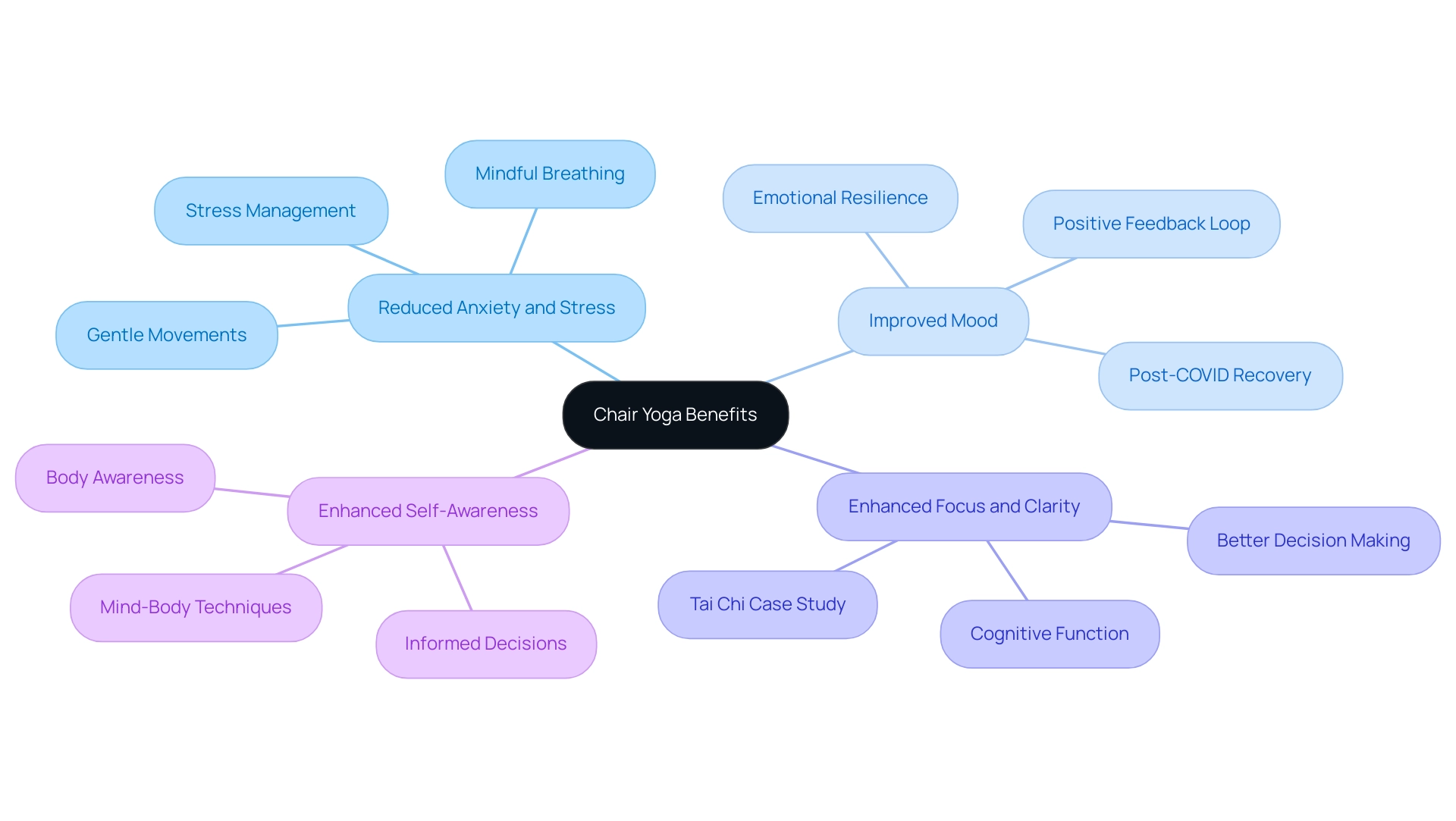
Conclusion
Chair yoga stands out as an inclusive and versatile practice, offering a myriad of benefits that extend far beyond weight loss. By adapting traditional yoga poses for a seated position, it provides individuals of all ages and abilities the opportunity to engage in physical activity, enhance flexibility, and cultivate mindfulness. Its gentle approach makes it particularly beneficial for seniors and those with mobility challenges, promoting not only physical health but also mental well-being.
The mechanisms by which chair yoga supports weight loss are multifaceted. While it may not burn calories at the rate of more vigorous exercises, it encourages consistent movement and muscle engagement, contributing to overall caloric expenditure and improved metabolism. Furthermore, the mindfulness cultivated during practice promotes healthier eating habits, essential for sustainable weight management.
Incorporating chair yoga into daily routines, whether at home or in corporate wellness programs, can lead to significant improvements in both physical and mental health. The practice reduces stress, enhances mood, and fosters a greater awareness of bodily sensations, all of which are crucial for maintaining a balanced lifestyle. As interest in chair yoga continues to grow, its role in promoting accessibility and inclusivity in fitness cannot be overstated.
Ultimately, chair yoga is not just a gentle exercise; it is a holistic approach to health that nurtures the mind-body connection. By embracing this adaptable practice, individuals can embark on a journey towards improved well-being, making positive strides in both their physical fitness and mental resilience. To explore how chair yoga can enhance your wellness program, contact us today for more information.




